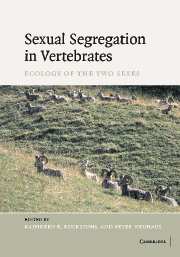Book contents
- Frontmatter
- Contents
- List of contributors
- Preface
- Part I Overview
- Part II Concepts and methodology
- Part III Foraging ecology
- Part IV Predator avoidance and reproductive strategies
- Part V Sex-related activities and social factors
- Part VI Sexual differences in ecology: comparisons within different taxa
- 13 Ecological divergence between the sexes in reptiles
- 14 Sexual segregation in Australian marsupials
- 15 Social systems and ecology of bats
- 16 Sociality and ecology of the odontocetes
- 17 Sexual segregation in non-human primates
- Part VII Implications for conservation
- Part VIII Outlook
- References
- Index
15 - Social systems and ecology of bats
Published online by Cambridge University Press: 04 September 2009
- Frontmatter
- Contents
- List of contributors
- Preface
- Part I Overview
- Part II Concepts and methodology
- Part III Foraging ecology
- Part IV Predator avoidance and reproductive strategies
- Part V Sex-related activities and social factors
- Part VI Sexual differences in ecology: comparisons within different taxa
- 13 Ecological divergence between the sexes in reptiles
- 14 Sexual segregation in Australian marsupials
- 15 Social systems and ecology of bats
- 16 Sociality and ecology of the odontocetes
- 17 Sexual segregation in non-human primates
- Part VII Implications for conservation
- Part VIII Outlook
- References
- Index
Summary
OUTLINE
Despite their small size (2–1000 g), bats have life-cycles comparable to those of much larger mammals, characterized by longevity, low fecundity and substantial parental care (Barclay & Harder, 2003). They also have very diverse life-cycles, with considerable variation in social systems and mating strategies (Altringham, 1996; McCracken & Wilkinson, 2000). There are currently believed to be almost 1100 species in 18 families, dominated by 5 very large families: Vespertilionidae, Rhinolophidae, Molossidae, Phyllostomidae and Pteropodidae (Koopman, 1993). Most species have not been studied, but enough is known about a small but varied minority to begin to understand the significance of the different social structures seen in bats.
Although a common feature in many mammals and often seen in sexually segregated species, marked sexual dimorphism in bats is rare. Female microbats are typically a little larger than males, but the differences are frequently only statistically significant with large sample sizes. One exception is Ametrida centurio, in which the females are markedly larger than the males (Peterson, 1965). The few instances of marked dimorphism are usually adaptations for sexual signalling, such as the enlarged nasal cavities of male hammer-headed bats, Hypsignathus monstrosus, and the erectile and scented hairs of the crested free-tailed bat, Chaerephon chapini (Altringham & Fenton, 2003).
So why do bats segregate by sex? Sexual segregation has been given relatively little attention in bats despite their diversity, their tendency to form large social units and indeed their tendency to segregate.
- Type
- Chapter
- Information
- Sexual Segregation in Vertebrates , pp. 280 - 302Publisher: Cambridge University PressPrint publication year: 2006
- 4
- Cited by



